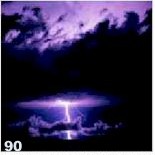|
PREV NEXT
 The
flashing within the rain core provides good background illumination for low
cloud banks and scud along a sharp gust front. Separate flashes may change the
shape and position of silhouetted clouds, but after a while you will recognize
the repeating shapes as reliable and abiding storm features. A large updraft
base will show up as a dark region,and if a lowering is present it will be a
bowl-shaped "dark hole "through which no light passes. The underside of these
dark regions can be studied over time for signs of a funnel or tornado. Quick,
frequent bolts mark the core region or the site of a new,maturing cell. The
flashing within the rain core provides good background illumination for low
cloud banks and scud along a sharp gust front. Separate flashes may change the
shape and position of silhouetted clouds, but after a while you will recognize
the repeating shapes as reliable and abiding storm features. A large updraft
base will show up as a dark region,and if a lowering is present it will be a
bowl-shaped "dark hole "through which no light passes. The underside of these
dark regions can be studied over time for signs of a funnel or tornado. Quick,
frequent bolts mark the core region or the site of a new,maturing cell.
Always remain aware of wind conditions,too.If the S-SE wind becomes calm,the
rain-free base and main updraft may be overhead.As soon as a cool wind from
the W-NW begins,you have moved into the outflow region and the threat for severe
effects will quickly diminish.The only other thing could be a strong wind before
precipitation begins,or hail as it peaks,but these threats will only last a
few minutes longer and are usually apparent from the other clues mentioned earlier.
Severe winter weather
Although the emphasis for severe weather watchers and spotters is on summer
severe weather, MSC also appreciates receiving reports of winter conditions
which may threaten public safety. These include low visibilities due to blowing
snow or dust, the rate and amount of snowfall, dense fog, and freezing rain.
Areas such as the Maritimes and B.C. receive far fewer summer severe events
but are battered by frequent bouts of severe winter weather and high winds in
the cooler half of the year.
From time to time weather warnings are issued in the winter, and you can be
our eyes and ears for your local area. The dangers associated with severe winter
weather should not be underestimated. Treacherous roads and bitterly cold temperatures
and/or windchills have killed many people. Canadians are sometimes surprisingly
ill-prepared for the "normal "extremes of our northern clime.
Weather warnings in winter
The criteria for issuing the following winter weather warnings vary from region
to region. Use these descriptions as a general guide only.
Blizzard Warning - Snow or blowing snow with a wind of 40km/hr or more
is expected, with visibility reduced to less than one kilometer and a windchill
of more than 1600 watts/m. All these conditions are expected to last six hours
or more (four hours in Alberta and Ontario).
Freezing Rain Warning - Slippery walking and driving conditions are expected,
with possible damage to trees and overhead wires (due to rain freezing on contact
to form a coating of ice).
Heavy Snowfall Warning - A snowfall of 10cm or more is expected
over a period of 12 hours or less.(In urban areas such as Vancouver a snowfall
of more than 5cm may occasion a warning.)
Snowsquall Warning - A snowfall of 15cm or more is expected over
a period of 12 hours or less, or visibilities are expected to be near zero for
4 hours or more.
Windchill Warning - Windchills of at least 2000watts/m (or 40km/hr winds
and -25 °C) are expected,making all outdoor activity dangerous.
Winter Storm Warning - When two or more winter conditions reach warning
proportions (for example,wind and snow, or freezing rain and a heavy snowfall)a
winter storm warning is issued.
You may also hear cold wave advisories from time to time.These are issued
when temperatures are expected to drop by 20 °C or more within 18 hours.(There
is some variation from region to region in the criteria for issuing cold wave
advisories or warnings, especially in British Columbia, where Arctic outbreaks
are of particular concern.) Hypothermia is always a risk under winter conditions,
but cold waves can catch people unprepared and exposed to both hypothermia and
frostbite.
PREV TOP NEXT
Created :
2002-08-26
Modified :
2002-12-19
Reviewed :
2002-12-19
Url of this page : http://www.msc.ec.gc.ca
/education/severe_weather/page32_e.cfm

The Green LaneTM,
Environment Canada's World Wide Web Site.
|